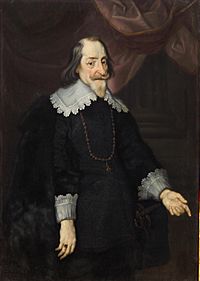Treaty of Fontainebleau (1631) facts for kids

|
|
| Signed | 30 May 1631 |
|---|---|
| Location | Palace of Fontainebleau, France |
| Expiration | 30 May 1639 |
| Original signatories |
|
| Parties | |
| Languages | German, French |
The Treaty of Fontainebleau (which means "agreement" in German) was signed on May 30, 1631. This happened during the Thirty Years' War at the Palace of Fontainebleau in France.
It was an agreement for eight years where France and Maximilian I, Elector of Bavaria promised to help each other. This treaty shows how complicated friendships were back then. France was friends with both Bavaria and Sweden. But Sweden was fighting against Emperor Ferdinand, who was Bavaria's ruler. This made things very tricky!
People tried to keep the treaty a secret, but it became known. Luckily for Bavaria, Gustavus Adolphus died in battle in September 1632. This stopped Sweden's plans to take over parts of Bavaria.
Contents
Why was the Treaty of Fontainebleau needed?
For a long time, from about 1520 to 1750, European politics was shaped by a big rivalry. This was between the kings of France and the Habsburgs. The Habsburgs were a powerful family who ruled Spain and the Holy Roman Empire.
In the 1620s, France had its own problems with religious wars. So, Cardinal Richelieu, who was like the chief minister of France, avoided open fighting with the Habsburgs. Instead, he secretly gave money to their enemies. These enemies included the Dutch, the Ottomans, and Denmark. They were all involved in the Thirty Years' War.
Richelieu also wanted to create another strong power in the Holy Roman Empire. He supported the Wittelsbachs, who ruled Bavaria and other areas. The Holy Roman Emperor was chosen by seven important leaders called Prince-electors. Richelieu hoped to influence who became Emperor by supporting the Wittelsbachs.
How the Thirty Years' War started
The Thirty Years' War began in 1618. It started when a Protestant leader named Frederick became king of Bohemia. Many German Protestants stayed out of the fight at first. They saw it as a disagreement about who should inherit the throne.
With help from Bavaria, Emperor Ferdinand quickly stopped the Bohemian Revolt. Then, he invaded Frederick's home region, the Palatinate. By 1622, Frederick was forced to leave, and Maximilian of Bavaria took control. In 1623, Bavaria was given the Palatinate's vote for choosing the Emperor. This gave the Wittelsbach family two votes.
However, taking Frederick's land changed the war. It brought in other countries. In 1625, Christian IV of Denmark, a Protestant king, invaded northern Germany. He had some success but was defeated by the Emperor's general, Wallenstein. Denmark was forced to leave the war in 1629.
The Edict of Restitution
After this, Emperor Ferdinand made a new rule called the Edict of Restitution. This rule said that any land that had changed hands since 1552 had to go back to its original owner. This usually meant it went back to the Catholic Church. This rule basically undid an older peace agreement from 1555.
This made many moderate Protestants, like the leaders of Saxony and Brandenburg, angry. It forced them to oppose the Emperor. This reignited the Protestant cause. In 1630, Gustavus Adolphus of Sweden, a powerful Protestant king, landed in Germany. He quickly pushed Wallenstein's army out.
Richelieu used this chance to create a group against the Habsburgs. This group included Sweden, Saxony, Brandenburg, and other German Protestants. Adding Catholic Bavaria to this group made it more appealing to other parts of the Empire. It also helped Richelieu against people who said he favored Protestants.
How the Treaty was Agreed Upon

In January 1631, France and Sweden signed the Treaty of Bärwalde. In this treaty, Richelieu agreed to pay for Sweden's army for five years. In return, Gustavus promised not to attack Bavaria and other Catholic areas, as long as they stayed neutral.
However, the terms of this treaty were not very clear. Richelieu himself pointed out that if Bavarian officers were in the Emperor's army, it technically meant Bavaria was not neutral. Richelieu believed he could control the Swedish king, but Maximilian was not so sure. Gustavus had quickly shown he was stronger than the Emperor's armies. He also insisted that Frederick, the former ruler of the Palatinate, should get his land back.
Another idea came from Philip IV of Spain. Spain had been fighting for sixty years and was very tired. Philip suggested a "Habsburg alliance" to keep France and Sweden out of Germany. This alliance would include Spain, Austria, and as many German states as possible, both Catholic and Protestant.
But getting Protestant support meant getting rid of the Edict of Restitution, which Emperor Ferdinand did not want to do. Also, Philip wanted the alliance to help Spain fight France and the Dutch. These conditions were difficult. So, Maximilian saw a French alliance as a backup plan in case Sweden became a threat.
What the Treaty Said
The Treaty of Fontainebleau had several important parts:
- Parts One and Two said the agreement would last for eight years. Both sides would help each other with soldiers if their lands were attacked. This meant Bavaria would keep the Palatinate. France would provide 9,000 foot soldiers and 2,000 horse soldiers, or money instead. Bavaria would provide 3,000 foot soldiers and 1,000 horse soldiers.
- Parts Three and Four stated that neither France nor Bavaria would help anyone who attacked the other.
- Part Five confirmed that France supported Bavaria keeping the Palatinate's vote for choosing the Emperor. This had been agreed upon in 1623.
- Part Six required that the treaty and its terms be kept secret.
- Part Seven said that Maximilian's promises were subject to his loyalty to the Emperor and the Empire.
What Happened After the Treaty?
Ten days before the treaty was signed, on May 20, 1631, Catholic League forces attacked the Protestant town of Magdeburg. More than 20,000 people were believed to have died. This was one of the worst events of the entire war.
In August, a meeting was held where Catholic leaders stopped any changes to the Edict of Restitution. Because of this, Saxony joined forces with Gustavus Adolphus. Their combined army won a huge victory against the Catholic League in September at the Battle of Breitenfeld.
This battle completely changed the power balance in the war. By early 1632, Swedish forces had taken over much of Southwest Germany and Bavaria, including the city of Munich. However, Gustavus Adolphus died in battle in September 1632. This allowed Maximilian to get back the lands he had lost.
Images for kids
-
Map of the Holy Roman Empire in 1648
See also
 In Spanish: Tratado de Fontainebleau (1631) para niños
In Spanish: Tratado de Fontainebleau (1631) para niños


